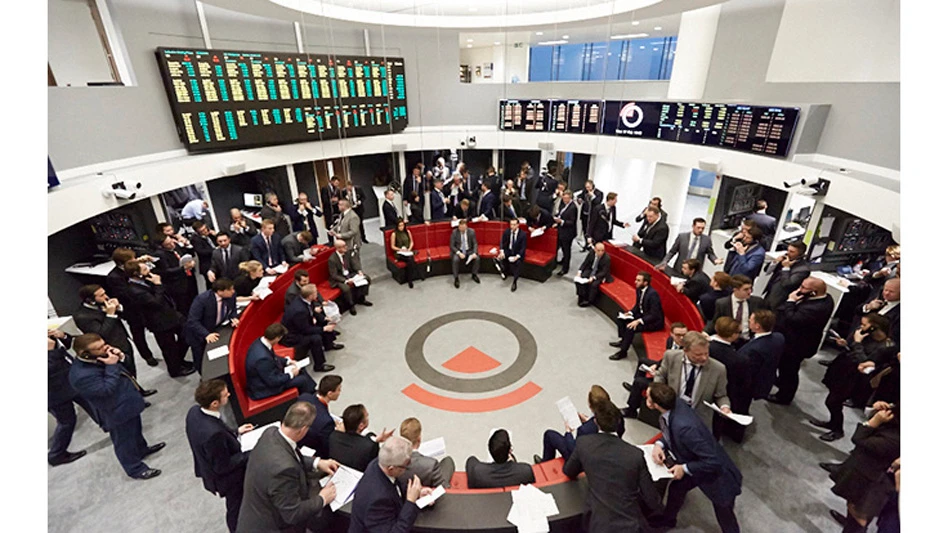
Photo courtesy of the London Metal Exchange
A report by consultancy Oliver Wyman commissioned by the London Metal Exchange (LME) in the wake of its nickel market shutdown of March 2022 says the price spike, like previous such events, was caused in part by “the build-up of large positions that trigger and end up on the wrong side of a major market move, thereby causing cascading client defaults.”
In the “description of events” section of the report, the consultancy writes in part, “Over the course of three trading days in March 2022, the price of nickel on the LME increased by over 270 percent, from $27,080 per metric ton to $101,365 per metric ton.” Oliver Wyman adds, “The events in nickel were a short squeeze, [when] rising prices create pressure on holders of short positions by increasing their margin call requirements.”
The United Kingdom-based consultancy spells out the bull versus bear positions that existed in that market prior to Russia’s invasion of Ukraine, with bulls focusing on “strong projected growth in electric vehicle (EV) manufacturing and consequent increased demand for nickel in batteries, along with generally strong demand growth as the global economy recovered from COVID 19 disruption.”
Bears meanwhile, saw an increase in nickel pig iron (NPI) supply likely leading to an oversupply in the global nickel market, especially if reported advances in technology allowing NPI be converted into battery material took place.
“Positions on both sides were large and concentrated when compared to nickel trading volumes,” the report states, in part referring to an imbalance between nonphysical and physical positions in the market at the time Russia invaded Ukraine, raising doubts about the global nickel supply situation.
According to Oliver Wyman on March 7, 2022, “One financial client with no material existing nickel position started to accumulate a long position on the exchange that reached over 2,000 lots [12,000 metric tons] by end of day. This represented 13 percent of net buying on March 7.”
At that same time, “Counterparties, including some of the biggest short holders, started to miss large bilateral margin payments on over-the-counter (OTC) positions,” the consultancy writes.
One contributing factor to the spiking price and the eventual freeze in LME nickel trading, the Oliver Wyman report states, involved an “absence of a diverse range of participants willing to take opposite positions. There were relatively few participants able and willing to profit take as the nickel price rose, with various aspects of market structure seen as deterring participation on the exchange. The withdrawal and absence of liquidity led to outsized impacts of trading from March 4 onwards, and price acceleration. This in turn triggered record margin calls, further increasing pressures on major short positions.”
For its part “The LME’s price volatility controls did not control price volatility during the events,” the report concludes. “While the LME had controls in the form of dynamic and static price bands, they did not ultimately stop the runup in prices. Effective volatility controls could have provided market participants with time to reflect, secure financing or seek ways to manage large positions off-exchange.”
To “extend the mandate of the LME’s risk and control functions to explicitly cover identification and prevention of market distortions, and upgrade capabilities accordingly” is the first of seven objectives for the LME that Oliver Wyman spells out.
Another objective asks LME staff to “monitor significant risks in the OTC market to manage risks of LME market distortions.” That ties into another objective urging staff to “calibrate position limits based on the LME market size and traded volumes so that they become effective protection against speculative positions causing extreme price fluctuations.”
The 44-page report, which can be accessed here, does not mention names of LME customers involved in the March 2022 incident, other than one chart that refers to a February Bloomberg news item identifying China-based stainless steel producer Tsingshan Holding Group as one of several companies holding a large short position on nickel on the LME. The financial market client who traded 2,000 lots of nickel March 7 is not mentioned.
Latest from Recycling Today
- BMW Group, Encory launch 'direct recycling’ of batteries
- Loom Carbon, RTI International partner to scale textile recycling technology
- Goodwill Industries of West Michigan, American Glass Mosaics partner to divert glass from landfill
- CARI forms federal advocacy partnership
- Monthly packaging papers shipments down in November
- STEEL Act aims to enhance trade enforcement to prevent dumping of steel in the US
- San Francisco schools introduce compostable lunch trays
- Aduro graduates from Shell GameChanger program





